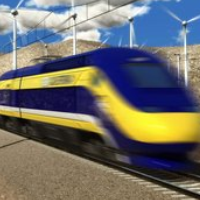Bullet Train Blows through Caution Signs; Next Stop D.C.

After months of very public debate, California lawmakers passed legislation by the narrowest of margins which all but assures folks from Bakersfield to Madera that one day soon they will be riding on high-speed rail through the sparsely-populated outposts of the Central Valley.
The rest of the state will be waiting to see if the federal government can extend the project to them. Of the $5.9 billion approved for this first stretch of track, $3.2 billion is from the federal government and $2.7 billion is state bond money.
California voters approved $9.9 billion for the project in 2008 when the price tag was $33 billion for a San Francisco/Sacramento-to-Los Angeles/San Diego route to be completed by 2020. And then the economy crashed.
Cost estimates quickly escalated, reaching $117 billion, before settling, for now, at around $70 billion. The completion date was pushed back nearly a decade. But even with the extra time, it looks uncertain that a state in financial distress and carrying enormous debt will be able to raise that kind of money itself.
The federal government has earmarked $41 billion for the California High-Speed Rail Authority through 2026. Much of the money came from hotly contested stimulus funds provided by the Obama administration’s economic recovery program and the prospect of further assistance in the near future is slim.
The state’s Legislative Analyst’s Office warned in 2011 that additional funding assumed in a 2009 business plan was “highly uncertain” and, more specifically, “Federal funding assumptions appear unrealistic.” Comparing the rail system financing to the steady revenue stream from an excise tax on gasoline that built the country’s interstate highway system, the Analyst wrote, “Given the federal government’s current financial situation and the current focus in Washington on reducing federal spending, it is uncertain if any further funding for the high–speed rail program will become available.”
Supporters of high-speed rail argue that mega-projects like this can rarely identify precisely how they will be financed over their long development and construction stages. Now that the train has received a green light from the Legislature, the most pressing challenge for the state is how to hurdle through the regulatory system and remaining political barriers to start writing checks before federal deadlines for spending the money it has expire.
–Ken Broder
To Learn More:
California Senate Vote Keeps Bullet Train Alive (by Chris Megerian and Ralph Vartabedian, Los Angeles Times)
Federal Support for High-Speed Rail Unclear (by Michael Doyle, Fresno Bee)
Rail Requires High-Speed Spending (by Ralph Vartabedian, Los Angeles Times)
Governor Rolls Back Rail Dodge of Pollution Laws at High Speed (by Ken Broder, AllGov)
High-Speed Rail Is at a Critical Juncture (Legislative Analyst’s Office)
- Top Stories
- Controversies
- Where is the Money Going?
- California and the Nation
- Appointments and Resignations
- Unusual News
- Latest News
- California Forbids U.S. Immigration Agents from Pretending to be Police
- California Lawmakers Urged to Strip “Self-Dealing” Tax Board of Its Duties
- Big Oil’s Grip on California
- Santa Cruz Police See Homeland Security Betrayal in Use of Gang Roundup as Cover for Immigration Raid
- Oil Companies Face Deadline to Stop Polluting California Groundwater





